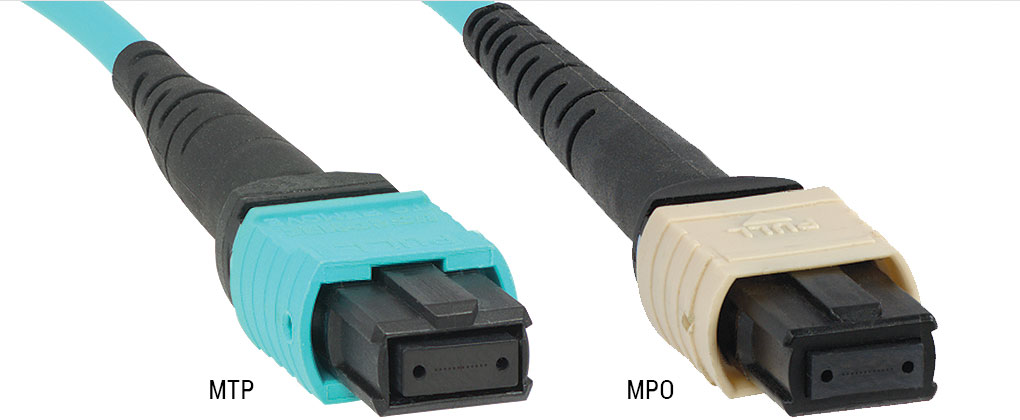Table of content
In the world of high-density fiber optic networking, the difference between MTP® and MPO cables is very important to understand. Both provide similar services, but their designs and the way they operate can have a dramatic affect on the efficiency and dependability of your network.
This article offers some side-by-side comparisons between MTP and MPO cables, including the aspects of mechanical design, optical performance, and application.
MTP® vs MPO Cable – What Are They?

MPO (Multi-Fiber Push-On) is a type of multi-fiber connector defined by IEC-61754-7 and TIA-604-5 (FOCIS 5).It is widely used in high dense degree fiber optic patch cords which are used in data center and telecommunication networks . It is the basis for the connection of several fibres (usually 8, 12 or 24) with one interface.
MTP® (Mechanical Transfer Push-On) is a trademark of US Conec for their MPO-style connector with improved performance. MTP® Connector are satisfied these mechanical and optic alimprovements within the limitations of MPO standard.
Comparison between MTP® and MPO Cable.
Mechanical Designs
Pin Clamp: MPO connectors commonly adopt a plastic pin clamp, which is easily to be broken in repeated mating process. The MTP® connectors utilize metal pin clamp with plastic housing, which is more durable and hard to break.

Floating Ferrule: MTP® connectors have a floating ferrule which nests with the outside diameter of fiber optic cables. This construction guarantees permanent contact under a load to provide better mechanical performance. MPO connectors do not have this capability.
Guide Pins: The elliptical shaped of MTP® Connector guide pins feature a smooth finish to reduce debris generation and wear during mating. Guiding Pin These use chamfered guide pins and can tend to create more debris and wear.

Detachable Housing – MTP® connectors have detachable housing so they can be removed and replaced for modifications with no re-termination. This is a feature that is usually not available with MPO connectors.
Optical Performance
Insertion Loss: MTP® connectors are designed to offer the lowest possible insertion loss in comparison with generic MPO connectors, making it an ideal solution for high density cable installations.
Reliability: The optimized MTP® connectors, including the floating ferrule and the better guide pins, enable a higher reliability and longer life, particularly in a frequently reconfigured environment.
Conclusion
MPO connectors, having been used for some time and suitable for many applications, lack some of the sophisticated design features that have been subsequently added to MTP® connectors for improved mechanical stability and optical performance. The MTP® connector can offer significant benefits to networks for which performance, flexibility and reliability are a priority, such as data centers and enterprise facilities.
MTP® and MPO Cable FAQs
Q1: Is MTP® connector the same as MPO connector?
A: Yes. The MTP ® connector is a high performance MPO connector that US Conec developed to improve the MPO (Multi-Fiber Push-On) design. Although all MTP® connectors are MPO-compliant, not all MPO connectors incorporate the Advantage of some or all of the ext ra features of MTP® connectors.
Q2: Can you mix MTP® connectors with MPO connectors?
A: Yes. MTP® connectors are supposed to play well with standard MPO connectors. Nevertheless, even if these can mate, performance enhancing characteristics of MTP® design of connectors may not be completely exploited when connected with a generic MPO connector.
Q3: MTP® or MPO which one cable shall I select in my network applications?
A: Whether to use MTP® or MPO cables, that depends on your network demand. If higher performance, lower insertion loss and higher durability is required, MTP® cables are recommended. For common use in which cost is the sole consideration, MPO cables can work.
Q4: What are the number of fibers MTP® / MPO connectors can be supported?
A: MTP® and MPO connectors can accommodate multiple fiber counts such as 8, 12, 24 and up to 72 fibers, depending on the specific connector type and application.
Q5: Why is polarity important for MTP®/MPO cabling systems?
A: Polarity makes sure that the transmit and receive signals are going to the correct places in a fiber optic system. Right polarity is not insignificant to MTP®/MPO cabling systems.
Q6: What are some common uses of MTP® and MPO cables?
A: Both cables are popular in data center, enterprise, telecommunications / high-density cabling, etc. MTP® is popular in applications requiring high reliability and low insertion loss, and MPO is generally used in the low-cost scenarios.
Q7: What is the maximum advised mating cycle of MPO/MTP® connectors?
A: Standard MPO connectors are usually tested to 200 mating cycles; MTP® connectors are capable of delivering in excess of 500 mating cycles and beyond thanks to its enhanced mechanical design.
Did this article help you or not? Tell us on Facebook and LinkedIn . We’d love to hear from you!






 https://network-switch.com/pages/about-us
https://network-switch.com/pages/about-us

























